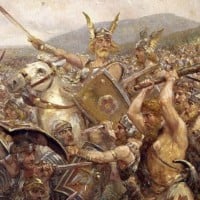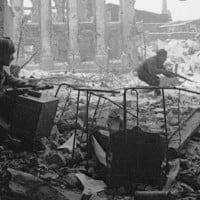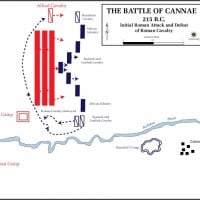Top 10 Greatest Battlefield Tactics of All Time
Many battles in the old days were won by a bunch of shirtless hairy guys screaming "BLOOOD!!!" and hacking at each other until one side is decimated. Nowadays, usually whoever is quicker at bringing out the atomic bombs wins the war. But, sometimes battles aren't won like that. Sometimes, you really need to use tactics, smart ideas and strategies, ambushes and traps, that will win you the fight. These cases are pretty rare, but there are some pretty good situations where amazing battlefield tactics have turned the tide. Please note that I got lots of the info here online. I hope you enjoy, because it took me a VERY long time to make this particular list.
In 9 AD, a huge army of Romans was lured into an ambush by these Germanic "barbarians." The Roman general led three legions through the Teutoburg Forest to suppress a Germanic revolt. When his 20,000 men were strung out along the line of march, the Germanic leader and his army, who were hidden in the forest, struck with the full force of their warrior army. Most of the 20,000 men were massacred.
The Roman defeat wasn't just bad, it was embarrassing. Ambushes demand patience and careful location-choosing, with precise coordination of each strike arm. The Germanic tribesmen, so often thought of as wild barbarians, were not thought to be able to plan such an organized attack.

This is one of the greatest examples of military strategy, and it happened very recently. The unexpected appearance of enemy troops on a side or from behind can damage an army's morale. If an army is encircled, it can be deprived of supplies or be attacked from any side. Eventually, if completely cut off, it must cut its way out, surrender, or fight to the death. This tactic is called envelopment, but it is rarely used as it is so difficult to pull off. The tactic was employed at Stalingrad by the Soviets against the Germans in Operation Uranus in 1942.
With the Germans pinned down and unable to maneuver, the Soviet delivered a heavy artillery bombardment from 3,500 guns on Romanian and Italian positions on either side of the city. Then, they unleashed several armored formations, including three tank corps. They combined mobility and speed with devastating firepower, driving deep behind German lines to cut off and then defeat the entire German army in Stalingrad.
Ever heard of Napoleon? He was the brains behind this one. At Austerlitz in 1805, Napoleon chose a deployment that would tempt the opposing Austro-Russian force to attack him on his right. In doing so, he knew he would be able to overextend his enemies. Although under significant pressure, Napoleon held his reserve back until he was absolutely certain the allies were committed, then he struck. His troops smashed the allied centre, beat off a counter-attack, and then curled around the isolated allied left. It was a decisive victory, won by the precise commitment of resources at the critical moment.
Sometimes, crazily enough, just dramatically and very suddenly charging at the opposing and stronger army can be intimidating enough to win the battle. This was the case at the Battle of Arsuf during the Third Crusade (1189-92). It pitted the Europeans against the Saracens, and things were not looking good for the Europeans.
The Europeans had marched under a rain of arrows for hours as Saracen archers tried repeatedly to goad them out of their tight formation. If they separated, they could easily be picked off one by one. So, obviously, they wouldn't do that, right? The Saracens thought so too, when suddenly, the knights charged at the Saracens' infantry and light cavalry. The effect was so dramatic and shockingly surprising that the Saracens broke and fled, or were crushed by the sheer weight of the attack.
Napoleon was certainly busy. This is the second time he's featured on this list, and it was in the same year! But this time, he had his defeat delivered to him. Napoleon ordered his men to concentrate all French and Spanish naval forces to break the Royal Navy and thus pave the way for the invasion of England. But a smart British military guy named Nelson proved adept at unnerving his adversary and off-balancing the French plans.
At Trafalgar, Nelson broke with the traditions of naval warfare and thrust two columns into the French line to bring about a fight where his men's superior seamanship and gunnery would win the day. The French were pinned into place and then thrown into confusion by Nelson's bold and courageous action, producing one of this country's most glittering victories.
Deception is something that works when you plant enough doubt in your enemies' minds that they change their plans. This worked a long time ago, during World War I. Anyways, the Royal Navy struggled to find a solution to U-boat attacks in the Atlantic. Yet, it was noticed early on that the Germans preferred to surface and use the less sophisticated main armament on the foredeck to sink their victims.
A number of 'Q-ships' were deployed as a solution. Q-ships are civilian vessels with concealed guns and big weapons and stuff. With holds packed with wood to enable them to float even when torpedoed, they were deliberately sent into areas where U-boats were known to be operating. As the U-boat surfaced, side panels were dropped to clear the line of fire for concealed guns, and by doing so, they sunk the U-boat after it surfaced to attack a merchantman off southwest England.
This is probably the most famous, other than the infamous "surprise attack!"
I like this one because it happened really recently, which shows how tactics can still be used today.
During various wars, the Netherlands have had to use crazy military tactics to win wars, the most notable of which occurred between 1584 and 1585, which I'll explain to you in a second. The Netherlands is a very low country. The only reason they aren't almost completely flooded is because of their dikes.
In this case, they literally moved the dikes and flooded their land, which was a very effective way of stopping the opposing armies. This enormous opposing navy would arrive, deposit an enormous force of soldiers, and the moment they got on the ground, "bye bye, land"! The Netherlands immediately flooded them. Hey, they can't invade something that doesn't exist!
I think that this is a type of warfare when you concentrate all of your forces on a very small portion of the enemy, like a flank. This works because the rest of the bigger army is much slower in getting to the small part of their army that is being attacked. By the time they get controlled and in the right direction, the portion of their army that the concentration was performed against will be decimated, and the army employing the concentration will have retreated.
An example of this was in 1917, when the Jagdgeschwader formations used this to win a battle spectacularly against the opposing Allied forces.
By far my favorite tactic. It was an ingenious plan that had never been used before because the technology for it hadn't existed prior. It allowed the Nazis to gain most of Western Europe and parts of Eastern Europe in just weeks. If it had taken the Allies any longer to get their act together, we might all be speaking German right now.
One of the tactics which requires the whole military. The best example is the capitulation of France after 4 weeks of fighting. The downside is that it is useless in long wars because it relies on quick and decisive battles.
